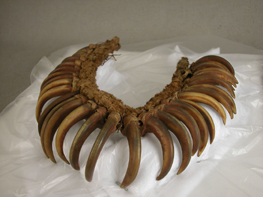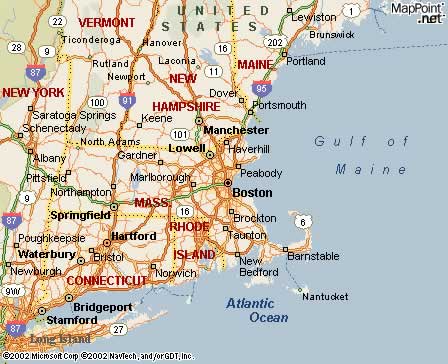|
|
Canku Ota |
|
|
(Many Paths) |
||
|
An Online Newsletter Celebrating Native America |
||
|
April 17, 2004 - Issue 111 |
||
|
|
||
|
New Lewis and Clark Artifact Found at the Peabody Museum, Harvard University |
||
|
by Peabody
Museum of Archeology and Ethnology press release
|
||
|
credits: photo
1: Bearclaw Necklace; photo 2: Acquisition Notecard
|
|
"Everyone at the Peabody feels a sense of awe at the power and beauty of this object, and great satisfaction that it will once again be available to enlighten us all about the world from whence it came." One of only a half-dozen surviving American Indian objects that can be positively attributed to Lewis and Clark, the necklace had been missing since it was first catalogued in 1899. David Borlaug, President, Lewis and Clark Fort Mandan Foundation, Washburn, North Dakota, and past-president, National Lewis and Clark Bicentennial Council said of the new discovery:
The necklace, probably given to the explorers by an Indian chief, was discovered during a storage inventory on December 17, 2003. In remarkably good condition, the necklace consists of thirty-eight bear claws, each approximately 3 inches long, attached with rawhide thongs to a fur foundation-possibly weasel. The claws were originally covered with a red pigment, now largely worn away. According to Gaylord Torrence, curator of Native American art, Nelson Atkins Museum of Art, Kansas City, and expert in early Native American artifacts, "Bear claw necklaces, which relate to the bravery and stature of warriors, were treasured by Indian people. They are rare from any time period. The newly discovered bear claw necklace acquired by Lewis and Clark is quite probably the earliest surviving example in the world." James Ronda, preeminent scholar of western exploration at the University of Tulsa, called the necklace "an absolutely extraordinary find" and "one of the most significant object finds in recent memory." Carolyn Gilman, curator of "Lewis and Clark: The National Bicentennial Exhibit" noted that "Artifacts that can be positively tied to Lewis and Clark are very rare… it is cause for celebration when another one turns up." Donated,
Undonated, Returned, and Rediscovered
In 1997, the Peabody Museum launched a new research project focused on the artifacts known as the "Lewis and Clark Collection" in anticipation of the Lewis and Clark Bicentennial. At that time, Associate Curator Castle McLaughlin and collections staff conducted an extensive search of the Peabody North American storage area in search of the necklace, without result. In December 2004, Two collections assistants working in the Oceania storerooms on an inventory and cataloguing project realized that a necklace they were photographing was incorrectly identified as Oceanic and notified the Collections Manager. The acquisition record for the misidentified object indicated that the Kimball family had indeed retained it in 1899, but a descendent then donated the necklace to the Peabody in 1941. At that time, a staff member erroneously catalogued it as an artifact from the South Pacific Islands, and thus it was "lost" in those collections. Necklace
to go on Display Spring 2004 For more informaiton on the Lewis and Clark Collection at the Peabody Museum, visit http://www.peabody.harvard.edu/Lewis_and_Clark/ |
|
|
www.expedia.com |
|
|
||
|
|
||
| Canku Ota is a free Newsletter celebrating Native America, its traditions and accomplishments . We do not provide subscriber or visitor names to anyone. Some articles presented in Canku Ota may contain copyright material. We have received appropriate permissions for republishing any articles. Material appearing here is distributed without profit or monetary gain to those who have expressed an interest. This is in accordance with Title 17 U.S.C. Section 107. | ||
|
Canku Ota is a copyright © 2000, 2001, 2002, 2003, 2004 of Vicki Lockard and Paul Barry. |
||
 |
 |
|
|
The "Canku Ota - A Newsletter Celebrating Native America" web site and its design is the |
||
|
Copyright © 1999, 2000, 2001, 2002, 2003, 2004 of Paul C. Barry. |
||
|
All Rights Reserved. |
||
 Peabody
Museum Director William Fash announced today that a rare Native
American bear-claw necklace acquired by Meriwether Lewis and William
Clark during their epic exploration of the American West, 1804-1806,
was discovered in a storage room at the Peabody Museum.
Peabody
Museum Director William Fash announced today that a rare Native
American bear-claw necklace acquired by Meriwether Lewis and William
Clark during their epic exploration of the American West, 1804-1806,
was discovered in a storage room at the Peabody Museum. Many
of the Native American objects acquired by Lewis and Clark were
given by them and by President Thomas Jefferson to the Peale Museum
in Philadelphia, at that time an unofficial national repository.
When the Peale Museum closed in 1848, the Lewis and Clark objects
were acquired by the Boston Museum, owned and operated by Moses
Kimball. In 1899, the Museum suffered severe damage in a fire and
was closed. The Kimball family donated 1,400 surviving objects to
the Peabody Museum at Harvard, including the Lewis and Clark expedition
artifacts. The Kimball family apparently changed their minds and
decided to keep the necklace rather than giving it to the Peabody,
which had already catalogued it and retained a Peale Museum label
describing it.
Many
of the Native American objects acquired by Lewis and Clark were
given by them and by President Thomas Jefferson to the Peale Museum
in Philadelphia, at that time an unofficial national repository.
When the Peale Museum closed in 1848, the Lewis and Clark objects
were acquired by the Boston Museum, owned and operated by Moses
Kimball. In 1899, the Museum suffered severe damage in a fire and
was closed. The Kimball family donated 1,400 surviving objects to
the Peabody Museum at Harvard, including the Lewis and Clark expedition
artifacts. The Kimball family apparently changed their minds and
decided to keep the necklace rather than giving it to the Peabody,
which had already catalogued it and retained a Peale Museum label
describing it. 